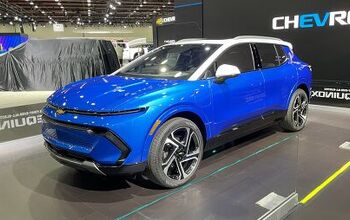2024 Chevrolet Equinox EV Review: Mainest of Mainstream

We’ve all heard it, thought it, or said it: EVs are generally just too expensive.
Well the 2024 Chevrolet Equinox EV is here to change that perception. While the Fiat 500e might have a lower list price, it doesn’t qualify for tax credits in both Canada and the US like this SUV does—to say nothing of the size, range, and practicality advantages. The Equinox EV is the Bow Tie’s Ultium-powered move into the mainest of mainstream, and the good news is that it delivers… but not without a few catches.
2024 Chevrolet Equinox EV Review: All The Details
What’s New for 2024:
The whole Equinox EV is. The smaller sibling to the Blazer EV rides on the same Ultium platform and uses the same 85.0-kilowatt-hour battery pack as the rear-drive model. The Equinox sticks to the more typical front- and all-wheel drive options of this compact crossover segment, however. It has a similar footprint to the gas model, though most of its interior measurements are actually fractionally smaller.
Exterior Style:
it’s pretty good-looking, right? The gas-powered Equinox is one dowdy-looking thing—although it gets a new rough-and-tumble look for 2025—but the EV is slick. Thin headlights and taillights are in vogue right now, but Chevy does enough to spice ‘em up, especially out back, with the arrow-like outer elements and segmented LED signature. This tester is a First Edition, which is essentially the 3RS, bringing in enormous 21-inch alloy wheels. They look cool, or at least would if they weren’t flat black.
On one hand, the silver of this tester really downplays the style compared to something like the excellent blue with a white roof that is available elsewhere. On the other hand, it’s a preview of what a lot of these things will look like on the road and hey, the Equinox EV does a good job blending EV futurism with classic proportions that won’t ruffle too many feathers.
Powertrain and Fuel Economy:
Chevrolet is keeping the lineup simple too, which is another plus. Every Equinox EV comes with a large 85.0-kilowatt-hour battery pack; no two sizes to keep price (and range) down here. This front-drive model puts down a useful 213 horsepower and 236 pound-feet of torque, numbers which grow by 7 each for 2025. An all-wheel drive option adds a second battery out back for 288 hp and 333 lb-ft, and there’s an upgrade for the new year there too. Range is the big selling point here: Chevrolet has extracted an impressive 319 miles (513 kilometers) out of the front driver, and 285 miles (459 km) out of the all-paw model.
And guess what? Those numbers are conservative, at least based on my driving experience. I picked up the Equinox EV at almost exactly two-thirds battery charge, and it was showing a hair under 240 miles remaining (386 km). I ran it nearly to empty and the displayed efficiency hovered right around the same range: about 4 miles per kWh or 15.5 kWh per 100 km. Now the math isn’t quite matching right—4 miles per kWh gives us 340 miles of range with this battery size—but still, range anxiety should not be a concern. Chevy rates every Equinox the same regardless of wheel size too; based on what we know with other EVs out there, the smaller 19s on lower trims should unlock even more.
I’ve seen other outlets comment on the tardy nature of the front driver. I don’t get it: the Equinox EV’s high-7s dash to highway speeds is wholly in line with what the typical gas-powered AWD models do. What’s more, it’s the incrementals between 0 and 60 (or 100 in Canada) that matter more for day-to-day driving. With the immediate responses of an electric powertrain, the Equinox is perfectly adequate for the daily grind, and that’s the point of this model. You want quick, you go for the Blazer EV.
Handling and Drivability:
The Equinox drives exactly as you’d expect: like a tidy, inoffensive compact crossover. There’s just enough weight in the steering wheel to remind you that yes, you are piloting a substantial amount of metal, glass, and battery. Maybe not the over 5,000 pounds Chevy quotes the curb weight at, as the Equinox does that usual EV trick of keeping its weight all low in the floor. It’s easy to place on the road with good sight lines.
One-pedal driving is on the menu, and it works naturally. Should you only want to dabble, Chevy continues to offer a small paddle behind the left steering wheel spoke to manually increase regen whenever you’d like.
Ride Quality and Comfort:
Ride quality is generally very good in the Equinox EV. The large wheels and tires of the RS do add a sharper edge to bumps as well as increased road hum, but I can’t overstate the calm of having a near-silent powertrain in this segment. The Equinox glides along on the highway, locked in and confident. This is where Chevy’s newest affordable EV is in its element, and in a more mature way than the Bolt could ever manage. Nonetheless, I’d like to try the smaller-wheeled car for a better idea of outright comfort potential.
The front seats are… fine. I couldn’t put my finger on why, but I could never get quite the right seating position for myself, despite not having that issue in the Blazer EV a few months ago. The seats look good and offer a decent range of adjustment, though I found lower back support lacking. This tester has a manual passenger seat; driver-side memory settings are available.
Interior Style and Quality:
The interior is where things start to go downhill for the Equinox. Not in the so-so material qualities or inoffensive design: again, this is a mainstream model, and it’s no worse than most RAV4s.
Chevy has got the basics down here: the front seats are reasonably comfortable (even if I don’t like how far forward the headrests are), the cupholders are capacious, and there’s useful storage under the center console. The interior measurements are slightly down on the gas-powered model but hey, look, in the back seat I have plenty of space anyway. The same goes for the trunk. No, the problem is the Equinox’s obsession with routing everything through that big, pretty 17.7-inch touchscreen (a smaller 11-inch setup is standard on lower trims).
Tech and Safety:
Pretty much everything I said about the Blazer EV’s identical infotainment setup applies here. The short notes version: while big, the screen lacks Apple CarPlay or Android Auto integration, forcing users to download versions of their most-used apps—and then they’ll require some sort of data plan to actually use them. No, Bluetooth with Spotify or Apple Music is not the same, Chevy. The driver-side display is crisp but has limited functionality, requiring deep dives into the touchscreen to modify displays such as trip data. There is entirely too much focus on music controls on the steering wheel.
On the plus side, native navigation does work well, automatically adjusting routes based on current charge or future needs. That is genuinely useful.
The Equinox EV has a long, useful list of driver assists. The typical stuff is present, though as was the case with the Blazer EV, I found the blind-spot monitoring overly aggressive, to the point that it activated at right turns if there was a vehicle moving behind me. The 360-degree camera is high-def and very useful, and Chevrolet’s Teen Driver mode continues to offer peace of mind for families.
Value Dollars and Sense:
Yes, the Equinox launched at a higher price than Chevy initially targeted. This Canadian-market RS First Edition is one of the pricier examples too, with an as-tested sticker cresting $55,000 CAD. The closest equivalent now is the top 3RS trim, which runs $46,795 ($54,899 CAD) including destination. Options are limited; the big ones are a dual-pane power sunroof and the Super Cruise package ($2,700 / $3,240 CAD).
Lower trims have brought the price down, and Chevy will have a model in the mid-30s (or low 40s for Canada) early next year. Remember that the Equinox EV is one of the few EVs to qualify for the full $7,500 tax credit in the US, and it suddenly becomes quite affordable.
Final Thoughts:
Chevy should be commended for bringing a spacious, efficient EV out at a price that is much, much closer to what people expect. I just wish it had less little annoyances; the Bolt showed Chevy could do EVs without issues, so the 2024 Equinox EV feels like a step back, nibbling away at product confidence. Nonetheless, for an affordable EV with huge range and a pleasant drive, the Equinox hits the target. Now the refining can begin.
Become an AutoGuide insider. Get the latest from the automotive world first by subscribing to our newsletter here.
2024 Chevrolet Equinox EV | |
|---|---|
Powertrain | 8 / 10 |
Efficiency | 9 / 10 |
Handling and Drivability | 7 / 10 |
Passenger Comfort | 8 / 10 |
Ride Quality | 4 / 5 |
Exterior Style | 4 / 5 |
Interior Style and Quality | 7 / 10 |
Infotainment | 6 / 10 |
Cargo Capacity and Towing | 4 / 5 |
Safety | 4 / 5 |
Value | 7 / 10 |
Emotional Appeal | 7 / 10 |
TOTAL | 75 / 100 |
Pros | Cons |
|---|---|
Affordable | Infuriating infotainment |
Efficient | Lower trims still coming |
Good looks | Not more spacious than gas model |
FAQs
Q: How much range does the 2024 Chevrolet Equinox EV have?
A: 319 miles (513 km) with the front-drive model, 285 mi (459 km) with AWD.
Q: Is the Equinox EV related to the gas-powered model?
A: No, despite sharing a name there is no commonality between the platforms.
Q: Where is the $35,000 model?
A: A lower-priced model will arrive early 2025.
Engine/Motor | 1 x electric motor |
Output: | 213 hp, 236 lb-ft |
Drivetrain: | FWD |
Transmission: | 1AT |
US Efficiency (kWh / 100 mi) | 31 |
CAN Efficiency (kWh / 100 km) | 19.3 |
Starting Price (USD) | $43,295 (inc. dest.) |
As-Tested Price (USD) | See text |
Starting Price (CAD) | $50,699 (inc. dest.) |
As-Tested Price (CAD) | $55,799 (inc. dest.) |

Kyle began his automotive obsession before he even started school, courtesy of a remote control Porsche and various LEGO sets. He later studied advertising and graphic design at Humber College, which led him to writing about cars (both real and digital). He is now a proud member of the Automobile Journalists Association of Canada (AJAC), where he was the Journalist of the Year runner-up for 2021.
More by Kyle Patrick











































Comments
Join the conversation